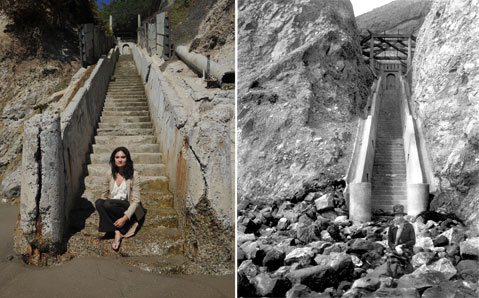City Faces Massive Repair Backlog
$500 Million Worth of Work Needed on Streets, Sidewalks, Buildings, Parks

Among government wonks, the word “infrastructure” has long enjoyed perverse sex appeal, but for mere mortals, it’s a certified buzzkill. This is the dilemma confronted by the City of Santa Barbara’s Nina Johnson, whose assignment has been to alert city residents over the next month the extent to which streets, sidewalks, buildings, and parks are teetering on the precipice of disrepair.
“I’m trying not to use the word ‘infrastructure,’” she said. “I don’t know if I’m making it any sexier, but these are the places we all use. They’re part of the Santa Barbara legacy.” Likewise, Johnson has made it a point to avoid such phrases as “general fund,” explaining, “I’m trying to make this accessible to people who’ve never attended a government meeting before.”
Writ large, the problem is huge. City Hall has a backlog of more than $500 million in infrastructure improvements that need to be made sooner rather than later. To keep the city streets in reasonable repair, Johnson said, costs $14.5 million a year; currently City Hall spends $3 million. And deferred maintenance comes with a steep price, she went on. The more repairs are delayed, the more expensive they become.
For instance, the city’s police station — vintage 1950s construction — will cost $54 million to rebuild to modern seismic standards. Thus far, there’s been little public support for rebuilding the station house, but, Johnson cautioned, the interim nickel-and-dime solutions aren’t cheap, either. She said City Hall has already spent a couple million dollars moving dispatchers from their basement dungeon to new digs in the Granada Parking Garage.
In the meantime, Johnson — a 15-year vet of the City Administrator’s Office — is taking her show on the road, holding eight public meetings and a host of other engagements targeting key neighborhood and business groups. “We want to know what people are comfortable with,” she said. “Are people comfortable shutting down certain pools and parks? What levels of street repair do they feel is necessary? Right now, the library roof terrace is off-limits because it’s not safe. Is that okay?”
Even though City Hall is currently spending millions a year on high-profile projects, many of those efforts — bridge replacements especially — are largely underwritten by federal grants. “There are no federal grants for the Thousand Steps stairway to the beach,” Johnson said. That, she said, would cost $1.5 million to $2 million. And that money, she added, does not currently exist. Based on the response from a meeting with community movers and shakers, Johnson said there’s a recognition that City Hall can’t do it all. “People understand a certain amount of triage will be involved.”
Johnson spent the better part of two months culling through archival photos contrasting the city’s assets in their prime with how they look today. What the public makes of this will have substantial weight on how a committee made up of Mayor Helene Schneider and councilmembers Bendy White and Randy Rowse decide to proceed. In addition, Johnson said she hopes her road show inspires people to talk about new technological possibilities they’d like to see explored.
Public discussions about infrastructure and deferred maintenance have a tendency to evolve into prickly debates about spending priorities. And lurking in the background is a possible half-cent sales-tax increase that city administrators have been eyeballing since the state abolished redevelopment agencies. For Santa Barbara, that constituted a loss of about $16 million a year. A half-cent bump in the sales tax would generate roughly $10 million a year. While that’s not enough by itself to make an appreciable dent in the $500 million repair backlog, it could generate a big-enough income stream, allowing the city to sell a sizable bond to finance such repairs.
Any such tax increase, however, would be inherently controversial and require a vote of city residents. That topic will not be included in Johnson’s presentation. “If people are okay with where we are, then there won’t be any Phase II,” she said, “let alone a Stage III.” Johnson’s next presentation takes place Saturday, October 4, at 2 p.m. at Our Lady of Guadalupe church, and at the downtown library on Monday, October 6, at 5:30 p.m. See independent.com/events and search “infrastructure” for all seven meetings.



